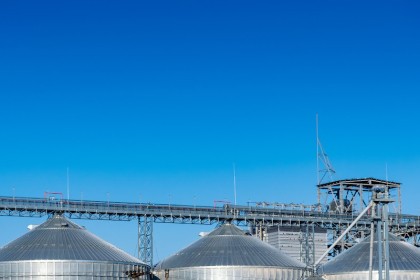
Breeding For Social Pigs Improves Finisher Performance
Growth performance is heritable and is affected both directly by the pig’s own genes and indirectly by the genes of its group mates. Recent studies show that there are heritable social effects on growth in the DanBred breeds, and that selection for social genetic effects on growth also improves the growth of DanBred crossbreds. Breeding for social pigs has the potential to improve productivity as well as animal welfare. Learn more about the future prospects for breeding for social pigs in this article.
Domestic pigs are social animals and highly adaptable to new environments. In conventional pig production, pigs are typically kept in relatively large groups of 20-30, with restrictions on resources such as space and feed availability.
The groups typically consist of non-related individuals, and the pigs are mixed with unfamiliar animals several times during their growth period. Therefore, social interactions, including competition for resources and dominance relationships, are important aspects of a pig’s life.
Damaging social behaviour may reduce welfare and growth performance
“Some social behaviours are potentially damaging and can, for example, result in wounds on the ears and tail that may lead to infections,” says Lizette Vestergaard Petersen, Research Assistant, Danish Pig Research Centre. “Similarly, aggressive fighting can be costly in terms of lesions or flank wounds and subsequent infections, but also in terms of energy consumption.”
Damaging behaviours such as these may reduce welfare as well as growth performance and increase fat deposition due to stress. Thus, breeding for social pigs has the potential to improve productivity as well as animal welfare.
Group mates’ genes affect growth
Growth performance is heritable and is affected by the pig’s own genes (direct genetic effects) and the genes of its group mates (social genetic effects). Heritability reflects the potential to change a population genetically through selective breeding. The heritability for growth in pigs is generally reported to be in the range of 20-40%. When social genetic effects are taken into account, the heritability increases to 30-50%, or even higher. This may be due to genetic variation in behavioural traits such as aggressive behaviour and subsequent lesions, for which a heritability of 4-43% has been reported.
Breeding for social pigs
Traditional individual breeding is based on the concept of measuring the pig’s phenotypes (e.g. growth), and then selecting the individuals with the best phenotypes to be parents of the next generation. However, this method is ineffective for social behaviours because they are complex and hard to measure objectively on a large scale. So far, the focus has been on quantifying and reducing the damaging consequences of social interactions.
With an individual selection, this implies selecting the pigs with e.g. the fewest tail bites or lesions. These pigs were not on the receiving end of the damaging behaviour, but they may actually be the pigs that perform the damaging behaviour, and it would be more useful to select the pigs that do not perform the damaging behaviour. Group selection has been a successful tool in achieving this in selection experiments, but in commercial breeding programs where genetic gain is desired in multiple traits, it becomes more complicated. New genetic selection methodology that relies on social genetic effects on group mates may be used instead.
Selection for social genetic effects on growth improves growth in crossbreds
Up until now, it has not been convincingly confirmed that selection for social genetic effects on growth will improve either growth or social behaviour in crossbred pigs in conventional production herds. Evidence that selection for social genetic effects on growth will improve growth in the offspring has been inconclusive: A small Korean study indicated that it worked in purebred pigs, but a Dutch study showed that selecting pigs for high sociability did not result in a higher growth rate in the crossbred offspring.
However, recent results from the Danish Pig Research Centre, which is in charge of the R&D activities in the DanBred Breeding Program, now provide solid proof that genetic selection for social genetic effects on growth will improve the growth of crossbreds: A selection experiment involving 4,728 crossbred DanBred Yorkshire × DanBred Landrace finisher pigs from a total of 1,171 litters and kept in 273 groups was performed at a Danish production farm. The pigs had been selected for either high or low social genetic effects for growth, and the results showed that selection efficacy was 37% with a 95% confidence interval of [-4, 78]. This means that the growth rate of each pig within a pen increased by 0.37 g/day whenever the sum of its pen mates’ social breeding values increased by 1 g/day. The difference in growth rate across groups was up to 60 g/day based on social breeding values alone.
Benefits are more pronounced in production herds with uniform starting weights
The study also showed that the benefits of selection for social genetic effects are more pronounced in production herds with relatively high uniformity in starting weight within the finisher pens. This may be explained by body weight being a determinant of competitive ability in pigs. The establishment and maintenance of dominance relationships are more likely to require the assessment of competitive ability through fighting in weight-matched pigs.
Future prospects for breeding for social pigs
Two recent studies performed as part of the DanBred Breeding Program showed that there are heritable social effects on growth in the DanBred breeds. If social genetic effects on growth are indeed a reflection of less damaging behaviours among pigs, then this additional genetic gain is also expected to lead to higher animal welfare in group-housed DanBred pigs.
“Preliminary results from the Danish Pig Research Centre’s selection experiment show that the pigs in groups with high social breeding values had fewer ear bites and were calmer than pigs in groups with low social breeding values,” details Lizette Vestergaard Pedersen.
Ideally, selection should be based on behavioural recordings rather than relying on the indirect measures of performance traits. In the future, automated recordings based on new camera technology and software to analyse pictures or videos may allow for this. Research in this area is progressing rapidly, but for now, the DanBred Breeding Programme will continue focusing on and researching social behaviours with state-of-the-art methods.
For other agricultural products and services, click here.












